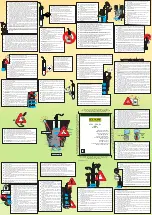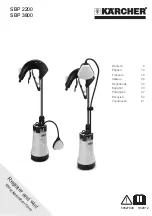
4
Instructions and Maintenance Sheets
Electric Test Pump “HEP0250”
ASSEMBLY AND OPERATING INSTRUCTIONS
The components are shipped unassembled to prevent breakage or unnecessary bulk during transport or the stockage
in warehouse. Before starting operations, check if the pump has been labelled with serial number and technical data.
Keep package for further transports or stockage.
Assemble the device in accordance with the next procedure, first checking that you have all the necessary material.
Use PTFE tape on all threads to prevent any leakage.
Before starting any operation, clean the tank to eliminate any residue or waste.
To avoid pressure oscillation due to air in the system, it is necessary to purge the air circuit to fill the system
completely.
1.
Assembly all components. The pump is provided with a pressure gauge and control valve.
2.
Place the pump body over the tank and fix it with the supplied screws.
3.
Screw one side of the supplied hose to the pump block and to the other the "TEST" valve
with the pressure gauge
.
4.
Place the equipment on a flat and solid area.
5.
Replace the transportation red cap with the ventilation yellow cap. The yellow cap does not guarantee a hermetic
seal, so keep the red cap for other needed transportation.
6.
Fill up the tank and ensure the suction tube is completely submerged. Use anticorrosive, antioxidant fluid or a
mixture of water and emulsifiable oil in order to prevent oxide formation inside the machine.
Check the suction
filter before any testing.
7.
Connect one end of the high pressure hose to the "TEST" valve and the other end to the system or equipment to
test (pipe, tank, valve, etc.).
8.
Before operating the pump always make sure pipe connections are clean and fully tightened up; all accessories
must be fitted correctly and
not damaged
: suction tube with nut and filter, pressure gauge and hose for high
pressure.
Always use protective goggles, shoes and gloves.
9.
Verify that electrical requirements of the motor are according to the electric power supply in the plant. Then,
connect the motor to the power line. Check that the motor runs correctly.
Ensure good motor ventilation. Check
that motor can have enough fresh air flow from the chassis. Do not allow water entering the motor.
10.
Pre‐fill the system or equipment before starting the test with the same liquid that will be used for testing.
11.
To start the test, s
witch on the pump and regulate the outlet value of the pressure using the red knob.
Never turn on the
pump when the pump is not connected to the plant.
12.
Pressure regulation device allows working at desired pressure. For pressure adjustment, turn the pressure
regulator (red knob).
Minimum pressure may change, depending on incoming plant pressure. If you only want to
set the pressure inside the pump, without filling the system, close the "TEST" valve.
13.
Check the pressure shown in the gauge and do not exceed the max. pressure.
14.
Close "TEST" valve when the desired pressure has been reached. In this way you will avoid an overheating of the
pump and will be able to test the system. For long time tests, it is possible to disconnect the pump from the
system keeping the pressure.
15.
Do not keep the motor running “ON” with the valve
"TEST"
closed. After a few minutes, temperature inside of the
pump will increase and could damage the gaskets
16.
To finish the operation, open the
"TEST"
valve.
17.
Water high temperature and air bubbles can change the pressure into the system. Have in mind this factor when
testing big plants with high temperature difference
.
Ensure that all the equipment and accessories
are suitable for the maximum working pressure.
The pump must always be handled
and repaired by qualified personnel.























